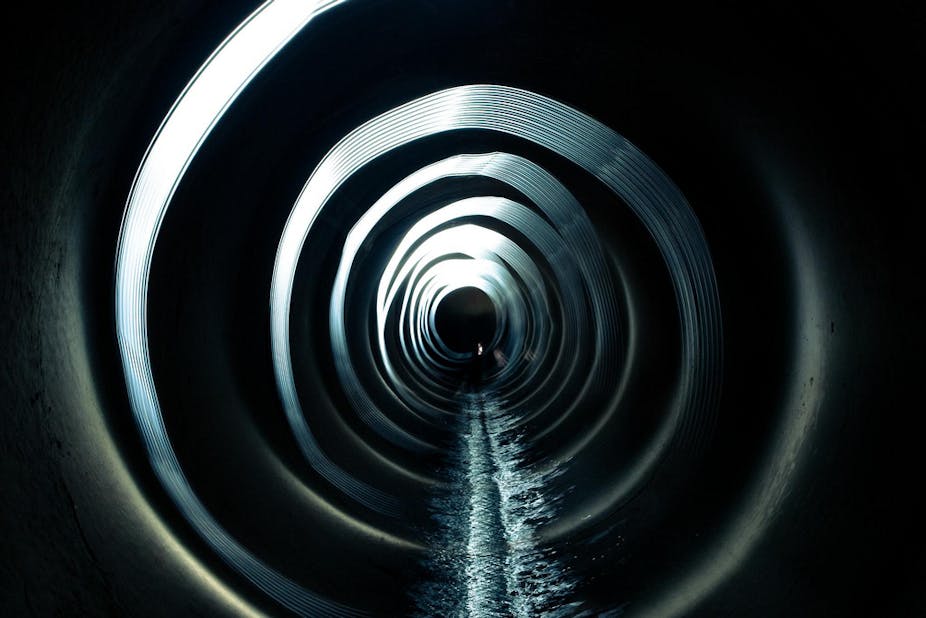Saving water is a good thing, right? But what if I told you it could also cause problems.
A recent study from Victoria University indicates water-conservation can have unintended consequences for residents and water managers - a problem that is only set to get worse.
Our research found that reducing and replacing potable water lead to smellier sewers and more rapid corrosion of the sewer pipes beneath our homes.
While our level of water use varies, our level of waste going into the sewer does not. So by reducing water and replacing potable water with rainwater, treated greywater and wastewater, we are simply creating more concentrated wastewater. It’s this concentrated wastewater that leads to a higher percentage of odour-producing gases and a greater rate of pipe corrosion.
Beneath Melbourne’s northern suburbs, sewer conditions were modelled under a current water conservation scenario and four water conservation scenarios for the residents: simple reduced water usage, greywater reuse systems, rainwater harvesting and wastewater recycling through sewer mining technology. For each scenario we also measured levels of hydrogen sulphide gas, the chemical largely responsible for pungent “rotten egg” sewage odours and corrosion of sewer pipes.
Current water conservation practice in the study area shows 30% of households installed a rainwater tank and 3% installed a greywater reuse system. From data collected in the study area, the average amount of hydrogen sulphide was found to be 18 ppm. This could threaten public health if this gas is accidentally released to the above ground environment and inhaled. The sewer pipe lifespan was estimated to be 147 years.
However, when four water conservation scenarios were modelled, all of them increased the hydrogen sulphide to various levels of concentration that could endanger public health.
The reduced usage scenario assumed residents were using about 22 litres a day less water per person. The impact of this scenario was calculated to reduce the average local sewer network’s lifespan through corrosion by 40 years, from 147 to 107 years, and raise the hydrogen sulphide levels by 12 ppm.
Greywater reuse systems
When calculating what might happen if all residents installed greywater reuse systems – using bathroom and laundry wastewater for toilet flushing and garden irrigation to reduce potable water consumption by 25% – results were more alarming. Hydrogen sulphide levels would increase by 46 ppm which could cause bad headaches, nausea as well as eye and respiratory injuries. Nobody likes smelly sewers in their suburb, but this really would be something intolerable.
The average lifespan of sewer pipes under those conditions would be reduced from 147 years to just 70 years, causing major issues for water authorities charged with maintaining and replacing the network.

Rainwater harvesting
Rainwater harvesting had less impact, resulting in a slight increase of hydrogen sulphide concentration and about six years in pipe lifespan reduction. The small impact in this scenario is due to the fact that using rainwater will not reduce the water consumption and wastewater production, but only replaces potable water in some indoor uses.
The slight smell and small reduction in pipe lifespan was due to small levels of organic concentration from roof runoff which is eventually stored in the rainwater tank.
Sewer mining
While other scenarios were assumed to be implemented at a household scale, the wastewater recycling through sewer mining technology was implemented at a neighbourhood scale. Sewer mining is a process of sewage extraction and treatment directly from sewer pipes to produce alternative water for indoor and outdoor use. In this study, sewer mining was modelled to supply alternative water to 70% of households in the study area and the residual treatment sludge was discharge back to sewer pipe.
Modelling showed the sewer pipes after the point of sewage extraction and sludge discharge had reduced levels of hydrogen sulphide gas. This is because some gas had gone to the sewer mining treatment plant. However, shortly after those areas the hydrogen sulphide gas levels increased rapidly to exceed current levels of hydrogen sulphide concentration.
At the study area outlet, the hydrogen sulphide was eight times the current concentration. In this outlet, the hydrogen sulphide had reached concentrations that cause eye, nose and throat irritation. The average pipe lifespan after the location of sewage extraction and sludge discharge was reduced by 32 years.
So what to do?
This study reinforces what Professor Stuart White from the Institute for Sustainable Futures at Sydney’s University of Technology has previously drawn attention to: smarter sewer pipe design is needed to anticipate the impact of increased water-saving technology use in the network. However, existing sewer pipes need a different technique to overcome issues of sewer odour and corrosion.
Even though there is no specific data on current pipe replacement/maintenance programs related to corrosion in the study area, other research has noted that to handle the problem of sewer corrosion by pipe replacement, rehabilitation or restoration, costs Australian water authorities billions of dollars.
With water security increasingly important in Australia and with more households applying water-saving measures there is an urgent need for research on this issue so water authorities can implement preventive measures or plan new sewer infrastructure properly.

